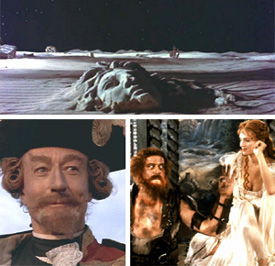THE TERRY GILLIAM FILES // "MUNCHAUSEN" (1989) |
Essay: THE ADVENTURES OF BARON MUNCHAUSENCover Notes for The Criterion Collection's special edition laserdisc, published in 1992
|  |
|
Writer-director Terry Gilliam likes to think of himself as the protagonist in each of his films. The loss of innocence portrayed in JABBERWOCKY and TIME BANDITS, the battles against bureaucracy inBRAZIL, and the struggle between commercial success and individual idealism in THE FISHER KING all reflect Gilliam's persona. In Hieronymous Karl Friedrich, Baron von Munchausen, the greatest liar in history outside of politics, Gilliam has found perhaps his closest fictional counterpart. Inspired by a soldier of fortune and eighteenth-century raconteur renowned for the gift of overstatement in regards to his travels and exploits, Munchaseun is a name synonymous around the world with a singular view of the universe — one which follows not physical laws of Nature but the whims and desires of those inhabiting it. With co-writer Charles McKeown, Gilliam uses the infamous Munchasuen tales as the basis of a story unbounded by the dictates of logic, or even taste. Their Baron, as might be expected, can only be accepted on his own wildly improbably terms. What pulls the viewer into the often overwhelming spectacle of THE ADVENTURES OF BARON MUNCHAUSEN is the mutually dependent relationship that develops between the 80-year-old Baron (who feels discarded by an age of scientific reasoning that has no understanding of the powers of imagination) and 8-year-old Sally Salt (who had the terrible misfortune of not being born the boy her pompous father wanted). Having found in Sally an eager audience for his tales of "three-legged Cyclopes . . . and oceans of wine," the Baron sets sail with her in a balloon fabricated from ladies' silk underwear to seek reinforcements — his trusty band of servants, each with a particular superhuman ability — against the invading Turkish army that has laid siege to their town. Like Sally's succombing to the Baron's romantic visions of what is possible, Gilliam was seduced by producer Thomas Schuhly into making the film in Rome, to take advantage of the artistic inspirations and craftsmanship available at Cinecitta Studios. Production designer Dante Ferretti, cinematographer Giuseppe Rotunno, and costume designer Gabriella Pescucci helped create a baroque fantasy that would never have been possible had the picture been filmed in Gilliam's home base of London. Originally budgeted at under $25 million, MUNCHAUSEN suffered through terrible financial wrangling between the producer and distributors, which only hinted at the outlandish and often absurd difficulties that marred the first weeks of production in Rome, and on location in Spain. Costume shipments were trapped in a customs strike, animals and cast members were felled by illness, storms wrecked sets, and crew members with fired or fled in alarming numbers. Gilliam persevered and achieved, in spite of the Brobdingnagian obstacles placed before him, one of the grandest yarns ever spun — certainly the most sumptuous film rendering ever made of the Baron's bizarre world. Like Gilliam's other films, MUNCHAUSEN is a visual feast, with uncanny designs and special effects that capture the organic style of Old World science-fiction visionaires such as Jules Verne. Beyond the fireworks, the performances offer splendid work by noted character actors and stars in cameo roles. John Neville expertly captures the liar's agility, romanticism, and search for purpose in a rapidly evolving world. Oliver Reed is both bellicose and timid as the hospitable god Vulcan, inflamed by jealousy for his beloved Venus (Uma Thurman in her first conspicuous role). And the vision of King of the Moon's detached head is a live-action version of a Gilliam cartoon if there ever was one. Most enjoyable is Sarah Polley, a completely natural young actress whose Sally Salt is exactly the brazen and redoubtable companion the Baron deserves. The triumph of imagination over reality, so often dreamed of in Gilliam's pictures, is here finally accomplished. THE ADVENTURES OF BARON MUNCHAUSEN stretches its horizons far wider than those of most Hollywood big-budget concoctions, which rarely dig as deeply into issues of Death, Responsibility, Reality, Artifice and New Uses for Lingerie. Gilliam (the Baron in a previous life, no doubt) has in this incarnation preserved and expanded Munchausen's unmitigated lies, topping the notorious storyteller several times over.
| |||||||||||||||||||||||||
copyright 1992, 2009 by David Morgan
All rights reserved.







